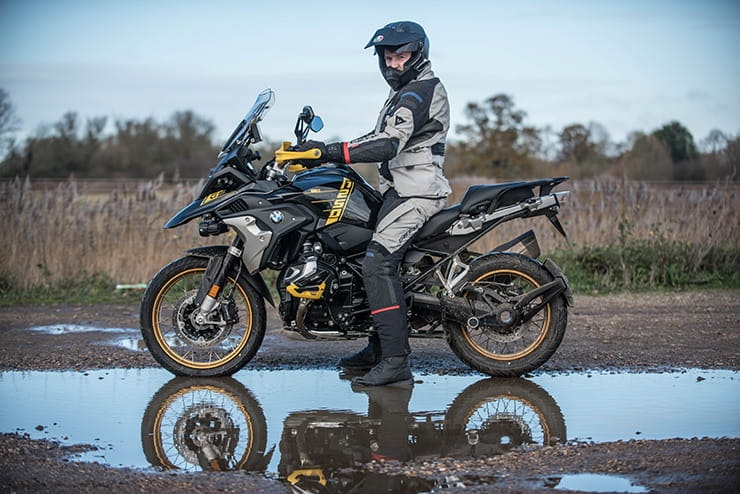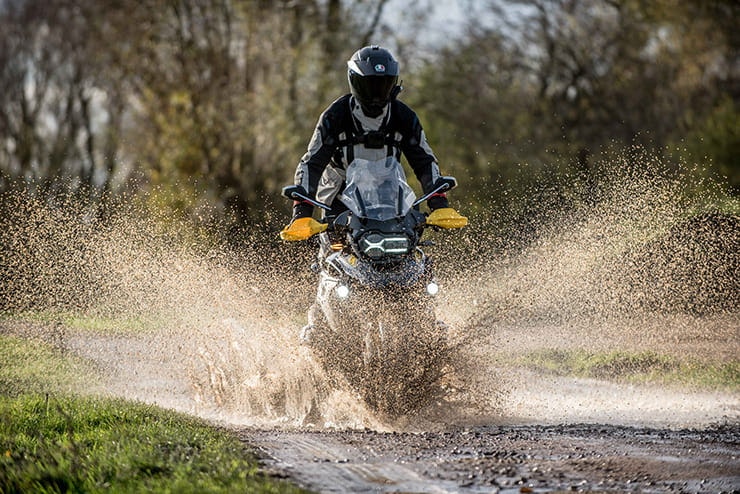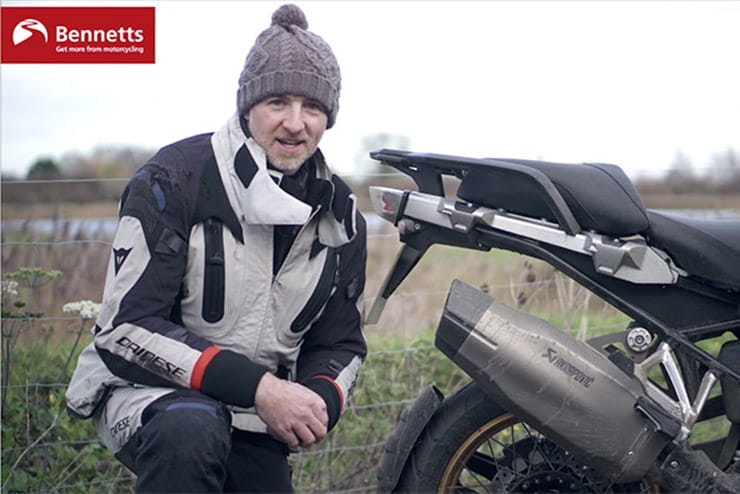The King of Bling - how many BMW R1250GS accessories do you need?
By Michael Mann
BikeSocial Managing Editor
04.01.2021
KIT CREDITS
Helmet
AGV AX9, £439.95 | www.agv.co.uk
Jacket
Dainese Antartica Gore-tex, £1,299.95 | www.dainese.com
Trousers
Dainese Antartica Gore-tex, £749.95| www.dainese.com
Boots
Dainese X-Tourer D-WP, £169.95 | www.dainese.com
Gloves
Dainese Universe Gore-tex, £189.95 | www.dainese.com
Cruise control, heated grips, top box, panniers, engine bars, fog lights, bar end mirrors, shorter screen, centre stand, radiator protector, silencer… the list goes on and on. And all of a sudden, once your £11,500 motorcycle has been specced up, it’s now closer to £14,000. And that’s just the factory-fitted options, we’ve not even started on aftermarket trinkets and goodies.
20 years ago you could walk into a car dealership, point at what you wanted and then whip out your cheque book or an envelope full of twenties and settle up. It was a simple and uncomplicated process. Your only decision back in those day was which colour to choose.
In the motorcycle world that was a realistic example as recently as five years ago. Well, except the cheque book bit. Of course, where the car world goes, the motorcycle version follows. So if the dealer can offer some personalisation in the shape of factory-built ‘packs’ or a catalogue of accessories then the buyer feels like they’re getting a more bespoke machine, suited to their needs. And it helps attract the buyer when your marketing department, in this case BMW, states the R1250GS range starts from £13,705.
“Ah, you would like wheels with that, sir? Well, they’re extra”. I may be facetious but, for the dealer, the money is in the accessories… and the finance agreement.
In fact, BMW tell us that 75% of all GS models sold are equipped with some form of accessory, and that the hard luggage is the most popular option. Yes, that’s a high enough figure but it still makes you think that 1-in-4 are happy with the standard bike and they don’t have anything fitted. I was expecting more than 75%.
Take this one, for example. It, and its predecessor, the R1200GS along with the bulkier adventure spec stablemates have been the best-selling powered two wheelers (above 125cc) for years. Why? Well, one of the reasons is because of the specification, if you’re buying new you can customise these until your hearts content, by paying for all the bits you do want but none of those that you don’t.
However, like me, there are plenty of folk out there who don’t fancy the complication of options. Having to make a decision of which pack(s) to add or spending hours trawling through the options list doesn’t entice everyone, some don’t have the time, inclination, budget or capacity. One tip is to consider the type of riding and journeys you're likely to be doing in six months/1-2 years down the line, i.e. think practically - if you're buying in the middle of a scorching summer you probably won't be considering heated grips but you'll regret that when the sub-zero temperatures of January come around.
Let’s take this specific bike, it’s the 40th anniversary edition of the BMW R1250GS whose ancestry can be tracked back to the R100 G/S while its rather stand–out black and yellow appearance is from the 1987 version. Meet The King of Accessories…
A closer look and review of the 40th anniversary BMW R1250GS
Introducing the real King of Bling, a big BMW with plenty of optional extras.
The 2021 TE edition on which it is based is available from £16,940, however this particular version of the 40th anniversary edition has had a few more parts added and can be yours for £21,460. That’s a 27% increase over the standard bike. On first glance you might just see a snazzy bit of yellow here and there, noticing the bumble-bee esque paint job, but let me run you through the extras:
The Dynamic Pack and Comfort Pack are included as standard with the TE model that already takes care of heated grips, keyless ride, dynamic electronic suspension, gear shift assist pro and riding modes pro. Over and above that, we have the actual 40th anniversary pack at £1990 (colour scheme, gold wheels plus Pillion Pack – effectively the standard screen instead of yellow and it’s also larger, different seat), an Akrapovic sports silencer at £875, LED fog lights at £370, Intelligent Emergency Call function at £305, what’s known as the Shadow Billet Pack II (mirrors, levers, foot rests, etc.) at £750 (the matching engine casings come with the 40th anniv. pack), £230 for the heated seats (which doesn’t come as standard on the 40th anniv edition because that has the flatter, bench-style yellow seat). Pillion has a switch while the rider has the option of changing it via this sparkly dash, alongside the heated grips.
All of a sudden, you’re looking at a £21,460 motorcycle. Ok, fine, so if you chose the PCP option then you’re financing a large chunk of the bike which realistically means you’re only paying for half the accessories once you three years are up.
If you’re smart and buy wisely, you can buy the extra bits that’ll suit you, and anyway factory parts will be covered under warranty.
FAST FACT: the R80 G/S cost £2449 in summer 1981 and according to Bank of England’s inflation adjuster that would have been £9458 in 2020, and right now, the entry-level F750GS 40th anniversary edition with Dynamic pack is exactly the same.
THE INSURER’S VIEW
According to Julian Abson, an Underwriter at Bennetts, the motorcycle insurance specialists, these are the accessory-related facts:
The customer has an obligation to enter all the details of the bike
Insurance is there to replace your bike like-for-like in the event of a claim. “We’ll put you back in the position you were in before the claim,” says Mr Abson
Accessories are more of an issue with second-hand market; what is the value? Does the owner understand what accessories are fitted?
Road-legal kit; insurers would worry more about after-market kit – how has it been fitted, by a professional? Is it road legal?
If you bought it from the manufacturer then it’s the manufacturer’s spec and they’ll have fitted it. If you tell an insurer you’ve fitted the braided brake lines, how is the insurer to know your brake line fitting ability?
We’re reminded that Bennetts cover 17 of the most common modifications as standard.
In terms of the type of aftermarket accessories that might add a bit of value to the bike then how about this for a top 5:
You should look at the number one item that we change – the exhaust. The days of swapping an end can and gaining 15bhp are long gone though. Modern standard-fit exhausts are complex devices, bristling with Lambda sensors and butterfly valves helping manufacturers get the most performance and the cleanest emissions. Unfortunately, these amazing pieces of engineering are often huge and ugly (Suzuki’s current GSX-R1000 being a prime candidate for that badge), meaning many of us rip off the pipe at the first opportunity and replace it with something prettier and lighter. In fact, many bikes come with an official aftermarket option and occasional official promotions that include it in the price.
A top-brand aftermarket pipe or full system definitely adds value to a bike, but only if the original is present too (because you might need it for an MoT test). Don’t forget that your definition of not-that-noisy might be different to a prospective buyer and most full systems need the fuelling sorting to allow for the lack of restriction. Carbon fibre silencers look cool but crash badly and look tatty with age too.
To get the best from your new exhaust you’ll need a mapping module or ignition re-flash. In many cases these work well on a stock bike too because they overcome fuelling and ignition functions in the standard map to help pass emissions test. For example, some bikes run rich fuelling at the point where the noise test happens because a rich-running bike is quieter. There’s no visible evidence of this being done, so as a buyer, make sure you see the dyno graphs and as a seller, make sure you have a copy to show.
Suspension
Making a bike for all sizes of rider and all types of riding style is impossible. So manufacturers have to compromise with suspension. Most of the time it’s ok, but every now and then a bike comes out that has the wrong spring for a particular market or damping too soft for how we’ll ride it. Yamaha’s original MT-09 and MT-07 are good examples of this and plenty have had their suspension tweaked by specialists.
Well, the latest top spec bikes have semi-active suspension, where damping is controlled electronically and that makes them hard to modify without changing the whole system. Early versions of these systems (BMW’s first generation ESA 15 years ago is a good example) were nowhere near as good as they are now and might actually make a bike worth less than the conventional version now. Older bikes will often need their suspension replacing so, aftermarket fork kits and shock absorbers are definitely worth seeking out. Although be aware that on a sports bike it might also be a pointer (in conjunction with many other things) that the bike has been raced.
Comfort
Like suspension, your bike’s screen was designed for an average rider. If that’s not you might find too much buffeting at high speed or problems for pillions. Or both.
Some bikes are worse than others, but in general, a taller aftermarket screen adds a small amount of value to a bike, as long as the original is available too.
The same goes for aftermarket seats or handlebars. Sometimes. If it’s for added comfort, then yes, as long as the standard ones are available. If it’s for cosmetic reasons, perhaps not, unless you also want some exactly the same and would have bought them anyway.
“Factory fitted heated grips should be standard on every bike”, said every British rider ever. Even in the summer, setting off at 6am with thin race gloves wrapped around lightly toasted handlebars is a pleasure. Some are better than others (BMW seem to be warmest and most reliable, Honda’s are not quite warm enough). The key term here is ‘factory fitted’ because with aftermarket versions it’s easy to do it badly, leaving a battery-draining, unreliable nightmare and, when one of them fails (which it will) you’ll be left with a single heated grip and one very cold hand?
Share on social media:


